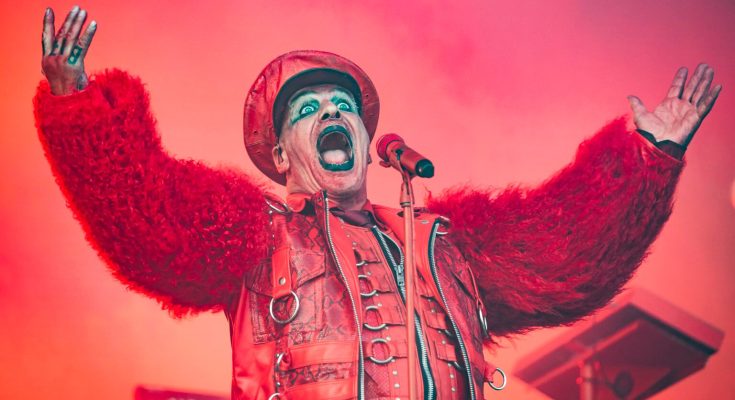Frontman Till Lindemann of Rammstein announces an arena tour and performs in front of 250,000 fans on his first solo run — a statement that not only captures the scale of his influence but also the enduring power of one of rock’s most controversial, electrifying figures. For decades, Lindemann has embodied the raw edge of industrial metal: provocative, theatrical, unapologetically intense. Yet this moment marks something more personal — the rise of Till Lindemann as a solo force, unshackled from the legacy of Rammstein, ready to show the world that his artistic fire burns just as fiercely on his own.
When the news first broke that Lindemann would embark on his own arena tour, the reaction was immediate and overwhelming. Fans across Europe, North America, and South America flooded ticket sites, many of which crashed under the surge of demand. Within hours, cities like Berlin, Moscow, and Mexico City had sold out their allocations, forcing organizers to add additional dates. The anticipation wasn’t just about hearing his distinctive growl or witnessing the trademark pyrotechnic chaos; it was about seeing how one of the most enigmatic frontmen in modern music would redefine himself outside the shadow of Rammstein.
And then it happened — the first night of the tour. A sea of 250,000 fans, packed into an open-air arena that felt more like a pilgrimage site than a concert venue. The crowd stretched as far as the eye could see, united by black attire, adrenaline, and the unmistakable energy that Till Lindemann commands. As the lights dimmed and a low hum began to vibrate through the floor, the audience roared — not out of expectation, but out of devotion. For many, this was a culmination of decades of following an artist who had dared to go further, louder, and darker than anyone else in his generation.
The show opened not with a bang, but with a haunting silence. A single spotlight illuminated Lindemann standing motionless, his face painted in stark monochrome. The audience held its breath. And then, the unmistakable voice — deep, resonant, filled with a mix of menace and melancholy — broke through the stillness. The first notes of “Ich hasse Kinder,” one of his solo anthems, reverberated through the arena, followed by an explosion of fire and sound that could be felt in the chest as much as heard by the ears. It was classic Lindemann: performance art colliding with brute-force rock.
But what made the night unforgettable was not just the spectacle. It was the sense of reinvention. While Rammstein has always been a collective — a band that thrives on chemistry and shared chaos — Lindemann’s solo project feels deeply introspective. His lyrics, often delivered in German, oscillate between aggression and vulnerability. Songs like “Lubimiy Gorod” and “Allesfresser” reveal an artist grappling with loneliness, identity, and the weight of fame. The imagery remains provocative, the visuals shocking, but there’s a sense of emotional honesty that cuts through the pyrotechnics.
As the concert unfolded, each performance seemed to peel back another layer of the man behind the myth. Between the bursts of flame and strobe lights, Lindemann would pause — sometimes for seconds, sometimes for minutes — staring into the crowd as if feeding off its energy. There were no long speeches, no overt sentimentalities, but his presence said everything. He was there not as the character “Till from Rammstein,” but as Till Lindemann, the poet, the provocateur, the survivor of an era where boundaries were meant to be broken.
The production design was nothing short of cinematic. The stage resembled a post-apocalyptic cathedral, complete with iron scaffolds, industrial smoke vents, and giant LED panels projecting surrealist visuals — twisted art that mirrored the emotional landscape of his songs. At one point, during the performance of “Frau & Mann,” a massive mechanical heart descended from the ceiling, pulsating in rhythm with the music as flames encircled Lindemann. It was grotesque and beautiful, a reflection of his entire artistic philosophy — finding beauty in chaos and humanity in the grotesque.
The crowd responded with a fervor rarely seen in modern music. Fans sang every word, their voices merging into one colossal chant. The emotional intensity was palpable; people cried, shouted, and embraced as the music carried them through a whirlwind of sound and emotion. In that moment, it didn’t feel like a concert — it felt like communion. Till Lindemann, the eternal showman, had turned performance into ritual.
Offstage, Lindemann has always remained an enigma. Known for his stoicism and philosophical outlook, he has often described his music as a way to process his own inner world — his fears, desires, and the contradictions of existence. The solo tour amplifies that narrative. Where Rammstein’s themes often touched on collective tension and political satire, Lindemann’s solo work delves inward, exploring the psyche of a man who has lived through fame, controversy, and artistic rebellion. Each song feels like a diary entry written in fire and blood, translated into sound.
In interviews leading up to the tour, Lindemann described this project as a “new chapter” rather than a departure. “Rammstein will always be part of me,” he said, “but sometimes you need to stand alone to remember who you are.” That sentiment resonates deeply with fans who have followed his evolution from East German poet to international rock icon. The solo arena tour isn’t a rejection of his past — it’s a continuation, a reinvention of his voice for a new generation.
Critics have been quick to note the shift in tone. Where Rammstein’s performances often leaned heavily on shock and satire, Lindemann’s solo act feels more human, more intimate despite its scale. There’s a poetic undercurrent that runs through every element — the choreography, the lighting, the sound design — all meticulously orchestrated to evoke not just awe, but introspection. His team, composed of avant-garde designers and musicians, has helped craft a soundscape that blends heavy metal with orchestral depth, creating something uniquely his own.
Beyond the music, Lindemann’s tour has also sparked conversation about artistic endurance. At an age when many rock legends slow down, he seems to be accelerating. Performing in front of 250,000 people is no small feat, yet Lindemann’s energy was boundless. Every move, every gesture carried intent — a living testament to the discipline and passion that have defined his career. The stamina it takes to command that level of performance night after night is remarkable, and yet for Lindemann, it feels instinctual.
As the show reached its climax, the atmosphere became almost surreal. During the encore, Lindemann returned to the stage dressed in white, a stark contrast to his usual black attire. The final song, a reimagined version of “Steh Auf,” built slowly, with the audience’s voices swelling into a collective roar. As confetti and sparks filled the air, Lindemann stood silently, eyes closed, absorbing the moment. Then, without a word, he bowed deeply — a gesture of humility that said more than any speech could.
By the time the lights came up, fans were still chanting his name. 250,000 voices echoing into the night, unified by one artist’s vision. In an era where many musicians rely on trends or digital filters to connect with audiences, Till Lindemann reminds the world that authenticity — even when it’s dark, disturbing, or difficult — will always have power. His artistry doesn’t seek to please; it seeks to provoke, to awaken something primal within the human spirit.
What this tour represents, beyond the numbers and the spectacle, is a declaration of creative independence. Till Lindemann has spent his career walking the line between genius and madness, poetry and violence, art and chaos. Now, standing alone on the world’s biggest stages, he proves that his voice — both literal and metaphorical — can fill arenas without compromise. It’s a rare thing in modern music: an artist unafraid to be misunderstood, unafraid to confront his audience with uncomfortable truths, and unafraid to keep evolving.
As the world looks ahead to the rest of Lindemann’s tour, the message is clear: this is not just a series of concerts, but a moment in cultural history. A reminder that music, when performed with conviction and courage, can transcend language, borders, and even fear. Till Lindemann, the man who once set stages ablaze with Rammstein, has now lit a new fire — one that burns just as brightly on his own.
In the end, perhaps that’s what defines a true artist: the ability to reinvent oneself without losing the essence of what made them great. For Till Lindemann, the arena tour isn’t a farewell or a reinvention — it’s a rebirth. 250,000 fans witnessed not just a concert, but a metamorphosis — the transformation of a legend into something even larger than legend itself: an immortal voice that refuses to be silenced, a force of nature that continues to define what it means to perform, to provoke, and to feel.



